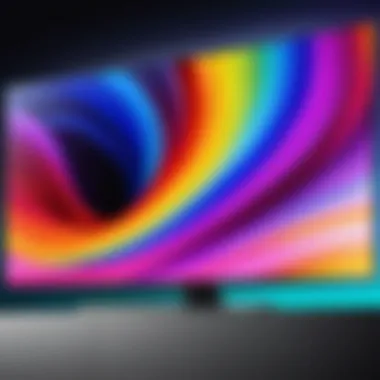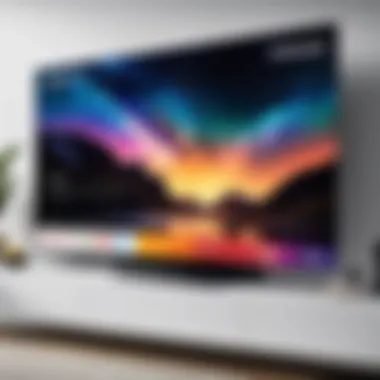Exploring the Future of Samsung OLED TVs Technology


Intro
The evolution of television technology has reached a pivotal moment with the introduction of OLED (Organic Light Emitting Diode) displays. Among the frontrunners in this arena is Samsung, a brand recognized for its innovative approaches and premium quality. This article delves into Samsung OLED TVs, focusing on their advanced technology, performance, and user experience.
As more consumers move towards high-definition viewing experiences, understanding the nuances of OLED technology becomes crucial. The unique characteristics of OLED displays, such as their superior contrast ratios, vibrant colors, and faster refresh rates make them appealing for both entertainment and professional purposes. In this examination, we aim to unravel the intricacies of Samsung's offerings in this segment, providing insights that aid IT professionals and tech enthusiasts alike in making informed choices.
Performance Metrics
Performance is a critical aspect when evaluating televisions, especially in a competitive landscape. Samsung's OLED TVs are engineered to deliver outstanding performance metrics that cater to various viewing experiences.
Benchmarking results
Samsung has earned accolades in benchmarking tests, often outperforming its competitors in both brightness and color accuracy. Key metrics include:
- Peak brightness levels that enhance viewing in well-lit environments.
- Color volume exceeding industry standards, providing deeper hues and better transitions.
- Exceptional response times, leading to smooth motion for fast-paced content.
Speed and responsiveness
The operational speed of Samsung OLED TVs is commendable. The interface is designed to be fluid and intuitively navigable, resulting in a positive experience when switching between applications or during input lag-sensitive activities like gaming. The integration of the latest processing technology contributes significantly to this responsiveness.
"High refresh rates and low input lag set Samsung OLED TVs apart from traditional LCD models, creating a seamless visual experience in gaming and live broadcasts."
Usability and User Experience
User experience plays a vital role in the adoption of new technology. Samsung OLED TVs embody a design philosophy that prioritizes user-friendly features.
Ease of installation and setup
Setting up these televisions is straightforward. The user manual, alongside an intuitive on-screen setup guide, simplifies the process, making it accessible even for those less technologically inclined. Users report minimal hassle in mounting or connecting additional devices, further enhancing the overall experience.
Interface design and navigation
The Tizen OS, which powers Samsung OLED TVs, is designed for simplicity. Smooth performance along with a visually appealing interface allows users to navigate through various services and apps easily. Key features include:
- A customizable home screen that prioritizes favorite apps.
- Quick access to frequently used applications.
- Advanced voice recognition to control the TV hands-free.
These usability features not only enhance the viewing experience but also encourage longer engagement periods with the device. By emphasizing user-centric design, Samsung strengthens its position in a competitive field, catering to the needs of both casual viewers and serious enthusiasts.
Prelude to OLED Technology
In the landscape of modern display technology, OLED (Organic Light Emitting Diode) represents a significant advancement over traditional LED displays. Understanding OLED technology is crucial when evaluating options for high-quality television displays, particularly for Samsung OLED TVs. OLED screens deliver enhanced visual experiences and distinct advantages that draw the attention of IT professionals and tech enthusiasts alike.
The core technology behind OLED involves organic compounds that emit light when an electric current passes through them. This allows each pixel to individually emit light, leading to profound differences in contrast and color performance when compared to conventional LED screens. The importance of this topic cannot be overstated, as OLED displays can directly impact user satisfaction and viewing experience.
The benefits and considerations surrounding OLED technology are crucial for anyone looking to integrate or upgrade their display systems. This includes evaluating the implications for power efficiency, longevity, and overall visual fidelity.
Understanding OLED Components
OLED displays are made up of several integral components. Each contributes to the overall functionality of the display. Here’s a breakdown of the key components:
- Organic Layers: The heart of OLEDs, made of organic molecules that emit light when electricity is applied.
- Substrate: Offers the mechanical support for the OLED layers, typically made of glass or flexible materials.
- Electrodes: Thin layers of conductive material that deliver current to the organic layers.
- Encapsulation: This protects organic materials from moisture and oxygen, which can degrade performance over time.
Understanding these components allows for a better appreciation of why OLED technology can offer superior visuals, such as deeper blacks and a broader color range.


Advantages of OLED Over LED
The advantages of OLED displays over traditional LED displays are significant:
- Superior Contrast Ratio: OLEDs can achieve true black levels since individual pixels can be turned off completely. This leads to a striking contrast that enhances image clarity.
- Wider Viewing Angles: The nature of how OLED displays emit light allows for more consistent colors and brightness from wider angles. This makes them ideal for group viewing.
- Faster Response Times: With quicker refresh rates, OLED panels handle motion better, reducing ghosting and blurring—important for action-packed content.
- Energy Efficiency: When displaying darker images, OLEDs consume less power compared to their LED counterparts, making them more energy-efficient overall.
In summary, OLED technology marks a substantial step forward in display performance. It combines artistry with technical proficiency, meeting the high expectations of today’s viewers.
Key Features of Samsung OLED TVs
Understanding the key features of Samsung OLED TVs is essential for consumers aiming to transition to a higher-quality viewing experience. The advanced technology of OLED displays results in richer colors and deeper contrasts compared to traditional LED TVs. Key features play a significant role in overall user satisfaction, and thus it warrants close examination. From display quality to integrated smart elements, these features define the differentiation of Samsung OLED models in the competitive market.
Display Quality and Color Accuracy
The display quality of Samsung OLED TVs is a defining aspect. OLED technology uses self-emissive pixels that provide exceptional brightness and contrast. Each pixel can turn off entirely, resulting in true blacks, which enhances the overall picture quality significantly.
Color accuracy also stands at the forefront. Samsung OLED TVs boast a wide color gamut, enabling the display of more hues than standard TVs. This means that colors appear vibrant and lifelike, a critical factor for photographers and videographers who rely on accurate color representation. Users watching films or playing video games will experience visual clarity that immerses them into the content.
"The ability to show true blacks and vibrant colors transforms viewing experiences, making them more enjoyable and true to the creator's intent."
Smart Features and User Interface
Samsung is also known for its comprehensive smart features that enhance user interaction. The user interface on Samsung OLED TVs is intuitive and straightforward. Samsung's Tizen OS powers the smart features, providing smooth navigation through apps and streaming services.
Users can access popular platforms like Netflix, Amazon Prime Video, and Disney+, simplifying the viewing process. Voice controls and smart home integration add further convenience. This makes navigating between various content options efficient and user-friendly.
Moreover, features like Ambient Mode allow Samsung OLED TVs to blend into their surroundings when not in use. These smart functionalities not only elevate aesthetics but improve the overall user experience.
Audio Technology Integration
Audio is critical when it comes to comprehensive viewing. Samsung pays attention to sound quality in its OLED line. The integration of Dolby Atmos technology sets Samsung OLED TVs apart. This creates an immersive audio experience that complements the visual quality.
The Object Tracking Sound feature is notable; it utilizes built-in speakers to create sound that follows the action on screen. This facilitates a cinematic experience directly from the TV, reducing the need for additional audio systems.
With these integrated sound technologies, Samsung ensures that users receive a complete package when it comes to home entertainment, combining both impressive visuals and audio to enhance overall satisfaction.
Performance Evaluation
The performance of a television set is a fundamental aspect that greatly influences consumer purchasing decisions. In the case of Samsung OLED TVs, understanding the specific performance metrics such as brightness, contrast, refresh rates, and viewing angles is crucial. This evaluation serves not only to showcase the technological advancements of these TVs but also to provide valuable insights for IT professionals and tech enthusiasts aiming to integrate cutting-edge display technology into their setups.
Brightness and Contrast Levels
Brightness and contrast are key parameters that significantly affect the viewing experience of Samsung OLED TVs. These TVs generally offer higher brightness levels compared to their predecessors. Samsung has implemented innovative technologies to enhance peak brightness, making images appear vivid and lively. Bright scenes are bright without losing detail in darker segments.
- Peak Brightness: Samsung's models can reach peak brightness levels that are commendable for an OLED display, providing more punch in HDR content.
- Contrast Ratios: OLED technology inherently provides infinite contrast ratios due to the ability to turn off individual pixels. This results in deeper blacks and a more immersive viewing experience.
Understanding how these brightness and contrast levels translate into real-world advantages is essential for consumers looking for an optimal viewing experience in various lighting conditions.
Refresh Rates and Motion Handling
Refresh rates and motion handling are critical for a smooth viewing experience, especially when it comes to fast-paced action scenes or sports. Samsung OLED TVs typically support higher refresh rates, enhancing fluidity in motion. This is crucial for gamers and sports enthusiasts.
- Variable Refresh Rates (VRR): Many Samsung OLED models support features such as VRR, which synchronizes the frame rates of the content with the display for a smoother rendering.
- Motion Interpolation: Samsung uses advanced algorithms to reduce motion blur, ensuring that quick movements are captured without ghosting.


These features provide great benefits for both gaming and watching high-action content, making performance evaluation essential to understanding how Samsung OLED TVs handle different types of media.
Viewing Angles and Distortion
Viewing angles play an important role in determining the overall performance of a television. Samsung has made significant strides in improving the viewing angles of their OLED TVs.
- Wide Viewing Angles: Unlike traditional LED TVs where color and brightness degrade when viewed from the side, Samsung OLEDs maintain consistent color and brightness across wider angles. This is advantageous for larger rooms where multiple viewers may be seated.
- Distortion Control: Samsung employs technologies to minimize color and brightness distortion at off-angles, ensuring that everyone in the room has an optimal viewing experience.
This capability is especially beneficial for home theaters or shared viewing spaces, reinforcing the importance of evaluating these elements when considering a Samsung OLED TV.
Comparative Analysis with Competitors
In the realm of high-end televisions, comparative analysis with competitors serves as a pivotal element within this article. By evaluating their features, technology, and pricing strategies in direct relation to Samsung, we can discern how its OLED offerings stack up against formidable brands like LG. This exploration provides insight into the nuanced differences that may influence consumer choice, especially for tech enthusiasts and IT professionals.
Samsung OLED vs. LG OLED
When discussing Samsung OLED vs. LG OLED, both brands display remarkable strengths. Samsung’s Quantum Dot technology enhances its OLED displays by improving brightness and color accuracy. This allows for vibrant images that captivate the viewer's eye.
In contrast, LG has established a solid reputation with its organic light-emitting diode (OLED) panels, known for their deep blacks and excellent contrast. This is primarily due to LG’s approach of allowing each pixel to emit light independently.
The differences don’t stop at panel technology.
- HDR Performance: LG typically performs well in high dynamic range, providing a more immersive viewing experience, particularly in dark scenes. Samsung, on the other hand, often excels in brightness under vibrant conditions.
- Smart Features: Samsung’s Tizen OS incorporates robust applications and a user-friendly interface, while LG’s webOS has its own suite of well-designed features.
Ultimately, the choice between Samsung and LG OLED may hinge on user preferences regarding picture quality, setup simplicity, and ecosystem compatibility.
Cost Comparisons Across Brands
Examining cost comparisons across brands is essential for understanding the value proposition each OLED TV offers. Generally, Samsung TVs present a range of prices reflecting their advanced technology. Entry-level models may start reasonably, yet high-end versions can reach premium price points.
In comparison, LG's OLEDs can often be found at slightly lower price points for similar specifications. This presents consumers with a dilemma, as they must weigh features against their budgets. Here are some considerations:
- Price Positioning: Some lower-tier Samsung models may outperform mid-range LG versions, while flagship models from LG could rival Samsung’s best.
- Value for Money: Buyers should assess warranty options and customer support, as these factors can impact long-term satisfaction.
Market Positioning and Brand Loyalty
The topic of market positioning and brand loyalty is critical in a saturated market. Samsung has successfully carved out a premium space among global consumers, leveraging its brand recognition and extensive marketing strategies. The company's enduring commitment to innovation and quality resonates well with consumers, fostering brand loyalty.
Assessing LG, the brand also maintains a strong market position, especially with its extensive range of OLED options suitable for various user needs. It has managed to cultivate a dedicated user base, encouraged by solid performance reviews and consistent product availability.
This loyalty impacts purchasing decisions significantly. Many consumers gravitate toward brands they trust, often opting for Samsung or LG based on past experiences rather than feature sets alone. Understanding these dynamics can provide valuable insight into market trends and influence sales performance in the OLED TV segment.
"Evaluating competitors is not just about features but understanding consumer preferences that ultimately dictate choices in high-end technology."
In summary, the comparative analysis between these two brand giants reveals critical insights that extend beyond superficial elements. Both Samsung and LG bring unique attributes to the OLED TV market, each catering to specific consumer needs and budget constraints.
User Experience and Feedback
User experience plays a crucial role in the success and acceptance of Samsung OLED TVs. In an era where digital consumption is ubiquitous, understanding how users interact with their devices can provide valuable insights. This section delves into the elements that contribute to a satisfying user experience, along with feedback received from current users. Considering aspects like installation, setup, reviews, and the quality of customer support is vital for anyone contemplating a purchase.
Installation and Setup
The installation and setup process of Samsung OLED TVs is designed to be as user-friendly as possible. It typically involves a few straightforward steps, including mounting the TV, connecting it to a power source, and linking it with other devices such as gaming consoles or Blu-ray players.


- Mounting Options: Users have the choice of using wall mounts or stands. Samsung provides detailed instructions to ensure the process is smooth.
- Smart Connections: The Smart Hub feature simplifies connecting to the internet and accessing various streaming services. Many satisfied users highlight how quick and intuitive the setup process is.
- Initial Configuration: Upon first use, guided setup options lead users through preferences for picture quality and sound settings, making it easy to achieve an optimal viewing experience.
Overall, the setup is generally perceived as hassle-free, which is important for users who may not be technically skilled. However, some have reported minor issues with integrating older devices, suggesting a need for better backward compatibility.
User Reviews and Ratings
User reviews highlight both positive aspects and areas for improvement. Samsung OLED TVs usually receive high ratings for their stunning picture quality and vibrant colors.
- Visual Quality: Many reviews emphasize the unparalleled contrast and deep blacks indicative of OLED technology. Users appreciate the natural color representation, effective motion handling, and brightness levels.
- Design: The aesthetic appeal of Samsung OLEDs also garners praise, as the slim profile and modern design enhance any living space.
- Smart Features: The availability of various streaming applications and smart functionality is consistently lauded, providing an all-in-one viewing experience.
However, some negative feedback points to concerns about customer service and troubleshooting challenges. A segment of users expressed frustration with the response time for repairs and the clarity of the guidance provided. This type of feedback is significant and suggests that while product quality shines, support services may need further refinement.
Support and Customer Service Insights
Customer support experiences vary among users, and this aspect can significantly impact overall satisfaction with Samsung OLED TVs.
- Accessibility: Samsung provides multiple channels for support, including online chat, phone support, and community forums. However, response times can fluctuate based on demand.
- Help Resources: Users often reference the Samsung support website as a useful resource for troubleshooting guides. Online forums, like those found on Reddit, frequently discuss common issues and user solutions, enhancing community support.
- Warranty and Services: Many consumers appreciate the warranty options available for Samsung OLED TVs, although some have reported that navigating claims can be complex.
Future Trends in Display Technology
The exploration of future trends in display technology is essential not only for understanding where the market is headed but also for anticipating its impact on consumer choices and technological integration. As we see a rapid evolution in display capabilities, it becomes crucial to consider how these advancements influence the user experience and what new features may emerge in Samsung OLED TVs. Future trends will likely encompass enhancements in efficiency, resolution, and interactivity, positioning Samsung to meet the growing demands of tech-savvy consumers and professionals alike.
Potential Developments in OLED Tech
Several developments are anticipated to reshape the landscape of OLED technology. First, manufacturers are focusing on improving efficiency, particularly in power consumption. This is crucial as increasing energy costs become a significant concern for many households. Enhancements in pixel structure may lead to lower power usage without compromising display quality.
Moreover, we can expect a move towards higher resolutions, such as 8K and beyond. As content becomes available in higher resolutions, consumers will look for TVs that can deliver that experience without artifacts like pixelation or blur.
Another promising area is flexible OLED displays. These can be integrated into different environments, allowing for innovative designs. For instance, wall-mounted TVs that can be curved to fit aesthetic preferences could revolutionize how displays are utilized in homes and businesses.
Impact of Emerging Technologies
The convergence of OLED technology with emerging technologies will likely yield significant benefits in terms of performance and user interaction. Virtual and augmented reality are two domains that are beginning to influence television performance metrics. As VR and AR content becomes more mainstream, OLED displays could provide the vibrant colors and deep contrasts necessary for an immersive viewing experience.
Artificial intelligence is also playing a role in shaping displays. AI technologies can optimize settings for viewers based on their preferences or even room conditions, such as lighting. This feature not only enhances the viewing experience but can also automate and simplify user interactions, which is particularly beneficial for less tech-savvy audiences.
In summation, future trends in display technology are not just about enhancing existing capabilities but also about redefining user expectations. As Samsung continues to innovate in this space, consumers can look forward to a more interactive, efficient, and visually striking experience.
Epilogue
The conclusion of this article underscores the significance of understanding Samsung OLED TVs in a rapidly evolving technology market. The advancements in OLED technology have brought about remarkable improvements in display quality, energy efficiency, and user experience. As the article details, OLED technology delivers superior contrast and color accuracy compared to traditional LED displays, making it a preferred choice for many consumers.
Summarizing Key Insights
Throughout this article, several key insights have emerged about Samsung OLED TVs:
- Display Quality: The vibrant colors and deep blacks improve the viewing experience significantly.
- Smart Features: The integration of a robust smart interface ensures seamless access to various applications and content.
- User Experience: Installation and setup processes have been streamlined, catering to both tech-savvy individuals and novices alike.
These insights highlight not only the technical strengths of Samsung OLED but also the practical advantages that can enhance day-to-day usage.
Final Recommendations for Consumers
If considering the purchase of a Samsung OLED TV, several factors should be taken into account:
- Budget Considerations: Evaluate the specific model within your price range. Some models may offer additional features that justify a higher price.
- Space Requirements: Think about the size of the room and seating arrangements, as the performance can vary with viewing distance.
- Additional Features: Assess the value of smart features and audio technology, based on personal usage habits.
"Understanding the strengths and weaknesses of Samsung's OLED technology can guide consumers toward making better purchasing decisions."
For further details on OLED technology and its benefits, check out resources such as Wikipedia or community discussions on Reddit.



